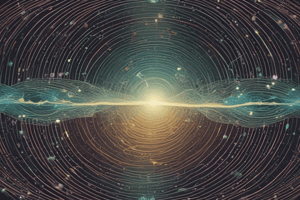Podcast
Questions and Answers
What is the primary characteristic of wave-like behavior in quantum objects?
What is the primary characteristic of wave-like behavior in quantum objects?
- Quantization of energy
- Diffraction and interference (correct)
- Definite position and momentum
- Superposition of states
Classical physics can fully explain the photoelectric effect.
Classical physics can fully explain the photoelectric effect.
False (B)
What is the significance of the threshold frequency in the photoelectric effect?
What is the significance of the threshold frequency in the photoelectric effect?
Below the threshold frequency, no electrons are emitted, regardless of the intensity of the light.
According to quantum mechanics, light is composed of particles called ______________.
According to quantum mechanics, light is composed of particles called ______________.
Which of the following is an example of particle-like behavior in quantum objects?
Which of the following is an example of particle-like behavior in quantum objects?
Quantum objects can exhibit both wave-like and particle-like behavior simultaneously.
Quantum objects can exhibit both wave-like and particle-like behavior simultaneously.
What is the name of the phenomenon where light hitting a metal surface can cause electrons to be emitted from the surface?
What is the name of the phenomenon where light hitting a metal surface can cause electrons to be emitted from the surface?
The energy of the emitted electrons in the photoelectric effect is dependent on the ______________ of the light.
The energy of the emitted electrons in the photoelectric effect is dependent on the ______________ of the light.
Match the following terms with their descriptions:
Match the following terms with their descriptions:
Flashcards are hidden until you start studying
Study Notes
Wave-Particle Duality
- Key concept: Quantum objects, such as electrons and photons, can exhibit both wave-like and particle-like behavior depending on how they are observed.
- Wave-like behavior:
- Diffraction: Quantum objects can bend around obstacles or through small openings.
- Interference: Quantum objects can interfere with each other, resulting in patterns of constructive and destructive interference.
- Superposition: Quantum objects can exist in multiple states simultaneously.
- Particle-like behavior:
- Definite position and momentum: Quantum objects can be observed to have definite positions and momenta.
- Quantization: Quantum objects can only occupy specific discrete states.
Photoelectric Effect
- Definition: The phenomenon where light hitting a metal surface can cause electrons to be emitted from the surface.
- Key features:
- Threshold frequency: Below a certain frequency, no electrons are emitted, regardless of the intensity of the light.
- Energy dependence: The energy of the emitted electrons is dependent on the frequency of the light, not its intensity.
- Explanations:
- Classical perspective: The photoelectric effect cannot be explained by classical physics, as it predicts that the energy of the electrons should be dependent on the intensity of the light, not its frequency.
- Quantum perspective: The photoelectric effect can be explained by quantum mechanics, which suggests that light is composed of particles (photons) that have a specific energy dependent on their frequency.
- Importance: The photoelectric effect was a key experiment in the development of quantum mechanics, as it demonstrated the particle-like behavior of light and the quantization of energy.
Wave-Particle Duality
- Quantum objects, such as electrons and photons, exhibit both wave-like and particle-like behavior depending on observation.
- Wave-like behavior is observed through:
- Diffraction, where quantum objects bend around obstacles or through small openings.
- Interference, resulting in patterns of constructive and destructive interference.
- Superposition, where quantum objects exist in multiple states simultaneously.
- Particle-like behavior is observed through:
- Definite position and momentum, where quantum objects have specific positions and momenta.
- Quantization, where quantum objects occupy specific discrete states.
Photoelectric Effect
- Defined as the phenomenon where light hitting a metal surface causes electron emission from the surface.
- Key features include:
- Threshold frequency, below which no electrons are emitted, regardless of light intensity.
- Energy dependence, where emitted electron energy depends on light frequency, not intensity.
- The photoelectric effect cannot be explained by classical physics, as it predicts energy dependence on light intensity, not frequency.
- Quantum mechanics explains the photoelectric effect, suggesting light is composed of particles (photons) with energy dependent on frequency.
- The photoelectric effect was crucial in the development of quantum mechanics, demonstrating light's particle-like behavior and energy quantization.
Studying That Suits You
Use AI to generate personalized quizzes and flashcards to suit your learning preferences.




